Deciding the right time to pick the cucumbers can be challenging for vegetable gardeners, especially if you are a beginner. Picking them too early leads to smaller and less tasty cucumbers, and a late harvest gives you bitter cucumbers. So when is the right time?
Cucumbers are ready to pick when they reach their full size and have a firm texture and bright, even color. Depending on the variety, this can range from 2-3 inches for pickling cucumbers to 6-8 inches for slicing cucumbers. Most cucumber varieties are ready to pick up 50 to 70 days after planting.
If you are a first-time grower of cucumbers and want to know the right time to pick them up, this is the right place for you. Here, we will share the time of picking cucumbers, the signs signifying that cucumbers are ready for picking, and how to harvest them.
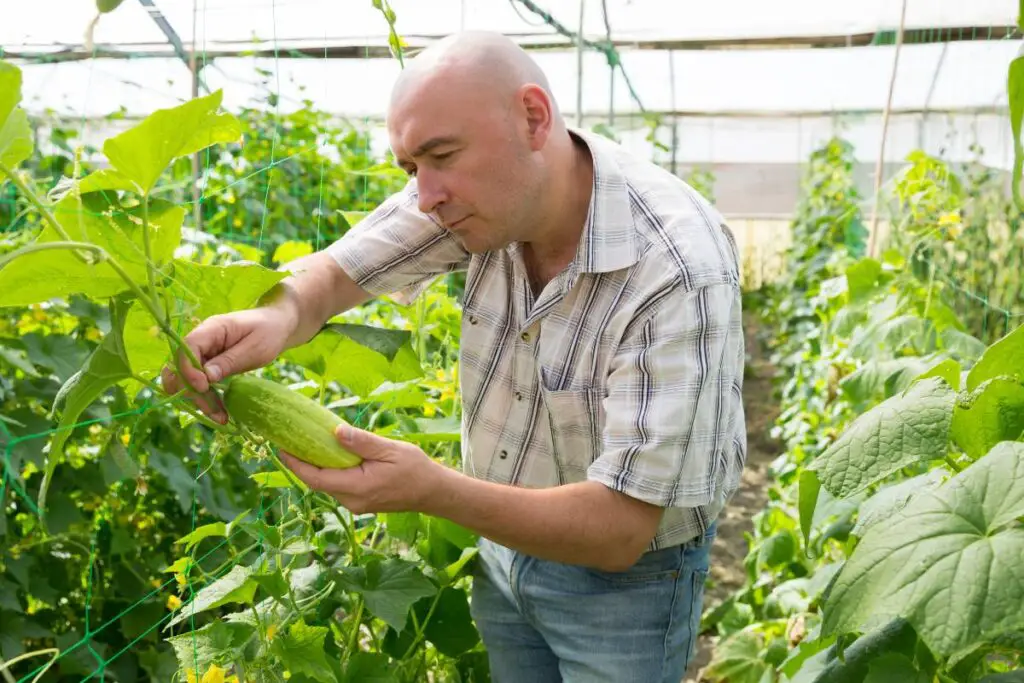
When is a cucumber ready to pick? – Signs of harvesting
While picking the cucumbers from the plant, knowing the right time to harvest them is essential.
Generally, two months or 50 to 70 days are enough for the cucumbers to prepare for picking.
Several factors can determine this timing because the cucumbers tend to ripe at different stages, based on how much sunlight, water, and fertilizers they have received and how frequently.
The cucumbers at the bottom take a longer time to mature.
The type of cucumber also affects the picking time because some varieties take less time, and some take more time to prepare for harvest.
That is why you must check and observe the cucumbers before harvesting them.
Fortunately, the cucumbers will have signs allowing the growers to know they are ready to get picked up.
Below I am sharing some symptoms to check before harvesting the cucumbers.
I also follow these symptoms before harvesting:
Color of the cucumbers
Cucumbers can vary in color based on the type. But most of them are dark green.
The green will be a shadowy vibrant deep green, along with a few light green marks on the body.
Once your cucumbers mature, they will become lighter green, nearly the color of the leaves.
The cucumbers will also have a dark hue contrasting the leaf colors.
When you see these colors, it is an obvious sign that the cucumbers are ready to get picked.
Cucumbers won’t be worth eating when they become yellowish with a rough surface. It is better not to let the fruits reach this color stage.
Identifying the signs of harvest in the Lemon varieties takes time.
It is better to pick them before they turn yellow.
If you wait for them to turn yellow, the cucumber will become too seedy and won’t taste good.
Size of the cucumbers
There are different types of cucumbers. When they reach their picking time, they will have different sizes.
Below are some different cucumber types and their sizes when they are ready to harvest:
- Pickling cucumbers, like Picklebush, are ready for picking when they reach 2 to 4 inches, and Gherkin is ready at 1.5 to 2 inches. Harvest the cucumbers when they are 2 inches for sweet pickles and 4 inches for dill pickles.
- The salad or slicing cucumbers, for example, the Salad Bush, are ready for picking when they reach 5 to 8 inches long and 1.5 inches in diameter. Most of them have dark green skin.
- Burpless cucumbers, also called English, European, or Seedless cucumbers, are ready to pick when they are 10 to 12 inches long and have deep green skin.
- The Japanese cucumbers should be harvested when they reach their ideal length of 8 to 12 inches and the skin is glossy green.
- Persian cucumbers are ready to harvest when they measure 4 to 5 inches long. They have a mild flavor with medium to dark green in color and smooth texture.
- Armenian cucumbers can be harvested two times. Harvest the cucumbers when they are 8 to 10 inches long. But if you want seeds, harvest them when they become 2 to 3 feet long.
- Some usual cucumbers, like Lemon, are picked when they reach ¾ to 1 inch long with a soft texture and pale green color.
Firmness and texture of the cucumber plants
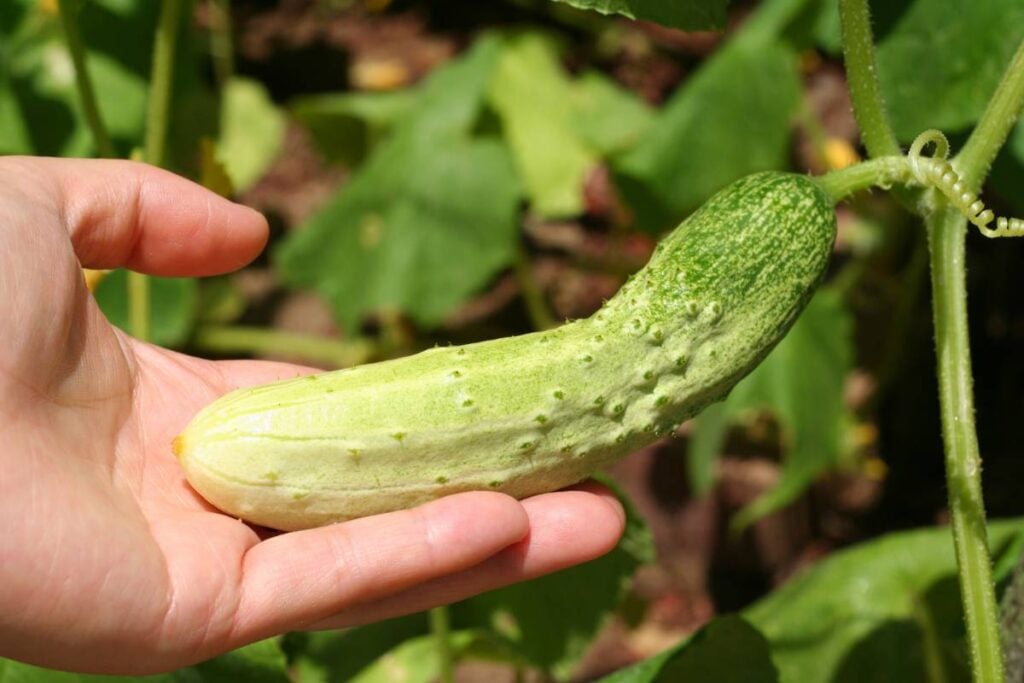
Check the firmness and texture of the cucumber plants before you harvest them.
Gently press the cucumber’s body with your fingers.
It must be firm and not too hard. Too solid fruit suggests it is still immature and needs more time to get picked up.
Some people harvest immature cucumbers because they are crunchy and have a mild flavor.
While holding the cucumber to check its firmness, feel the cucumber’s surface.
If your cucumbers have matured, they will have a bumpy texture.
Some cucumbers’ texture must be smooth, firm, and crisp. There should not be any softness or wrinkles.
Avoid picking up cucumbers with shiny skin, as they are still unripe.
The shape of the cucumbers
When you check the cucumbers’ size, firmness, or texture, check it for all the cucumbers. If not, at least most of them.
The cucumbers have three shapes – long, fat, and thin.
The longer cucumbers are the common ones to be used in most dishes.
However, the length can vary based on the type.
The fatter cucumbers are great for making salads as they are firm and sweet.
Some varieties, however, have thinner cucumbers, ideal for making pickles due to their intense flavor.
Check the ends
Taste the ends of the cucumbers to ensure they are ready to pick up.
If the end near the stem part tastes bitter, the cucumbers are not still ready for harvest.
The appearance of the stem near the cucumbers
When your cucumbers are ready to get picked up, the plant’s stem should be firm and green.
It should hold the cucumbers firmly without any issues.
The area around the stem remaining plump and healthy means the cucumbers are plumpy, juicy, and ready for harvest.
Number of days since the cucumber started growing
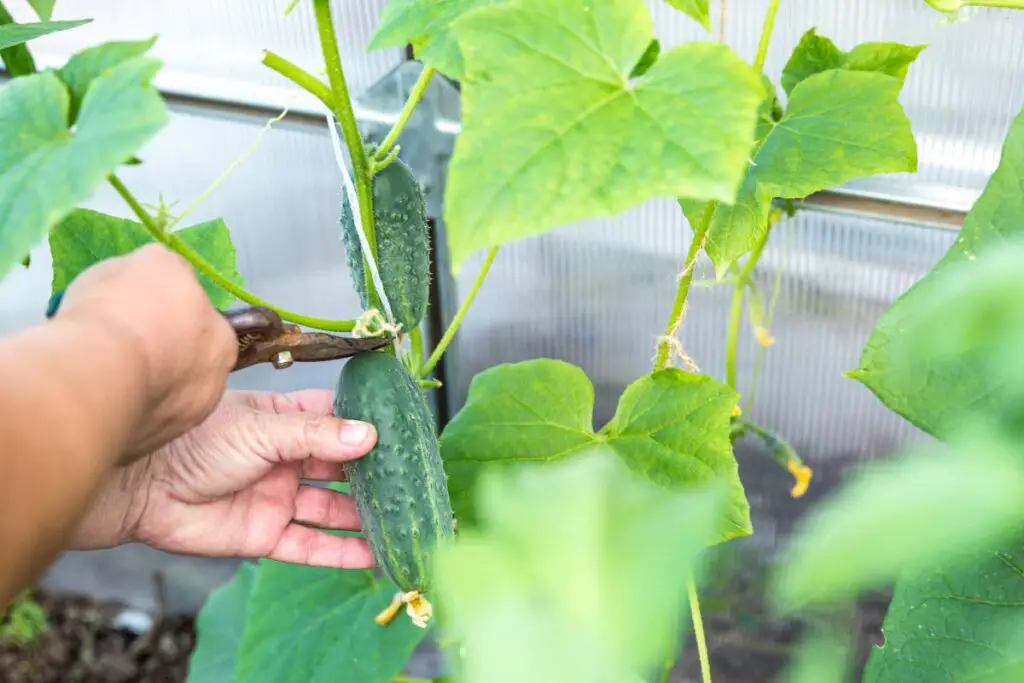
Generally, a cucumber prepares to get picked 50 to 70 days after planting.
Once a female flower grows in the plant and starts opening, the cucumbers take 7 to 10 days to become ready for getting picked.
But the days can increase and decrease based on the cucumber type and the amount of care guide received.
You must confirm the cucumbers with the above processes before picking them.
Looking for gardening supplies? We have tested 100's of products before recommending them to you guys. Check out our best pick below:
| Image | Gardening Supplies | Best Price? |
|---|---|---|
 Top
Top Top
Top | Raised Garden Bed Kit | Check On Amazon |
 | XLUX Soil Moisture Meter, Plant Water Monitor, Soil Hygrometer Sensor for Gardening, Farming, Indoor and Outdoor Plants, No Batteries Required | No Results |
 Top
Top Top
Top | 82 Pcs Garden Tools Set and Extra Succulent Tools Set | Check On Amazon |
 | Joeys Garden Expandable Garden Hose with 8 Function Hose Nozzle, Lightweight Anti-Kink Flexible Garden Hoses, Extra Strength Fabric with Double Latex Core, (50 FT, Black) | No Results |
 Top
Top Top
Top | Dual Chamber Compost Tumbler | Check On Amazon |
 Top
Top Top
Top | Sunnyglade Plant Stakes | Check On Amazon |
 Top
Top Top
Top | Organic Cold Pressed Neem Seed Oil | Check On Amazon |
 Top
Top Top
Top | Mighty Mint Gallon :-Insect and Pest Control Peppermint Oil | Check On Amazon |
 Top
Top Top
Top | Scotts DiseaseEx Lawn Fungicide | Check On Amazon |
 Top
Top Top
Top | Jacks Classic 20-20-20 All Purpose Fertilizer | Check On Amazon |
 Top
Top Top
Top | 30,000 Seeds Pollinator Attracting Wildflower Mixture | Check On Amazon |
 Top
Top Top
Top | Survival Vegetable Seeds Garden Kit-Over 16,000 Seeds | Check On Amazon |
Checking for bitter taste and seeds
Before I harvest the cucumbers, besides following the above symptoms, I do another thing.
I harvest only one cucumber and check for its taste and seeds.
When I started growing cucumbers years ago, I found them bitter and couldn’t find out why.
But after much experience and proper guidance, I understood I needed to pick them up on time for a sweeter taste.
If the cucumber has lots of seeds and tastes bitter, you are late to harvest them.
When the cucumbers have the accurate sweet, juicy, and refreshing taste, and the number of seeds is as expected, it is the right time to harvest them.
You can harvest the cucumbers early, but too early will not give you the right taste.
They are still immature if there is a very mild or no taste and zero seeds.
However, I prefer harvesting them a little earlier than the right time.
I enjoy the crunchiness and sweetness these young cucumbers provide.
Weather conditions and environmental factors
The weather conditions and environmental factors highly affect the timing of picking up the cucumbers.
Cucumbers mature at the right time if they receive ideal weather conditions for growth.
Here are some factors to consider while growing cucumbers and making them ready for harvest at the right time:
Sunlight
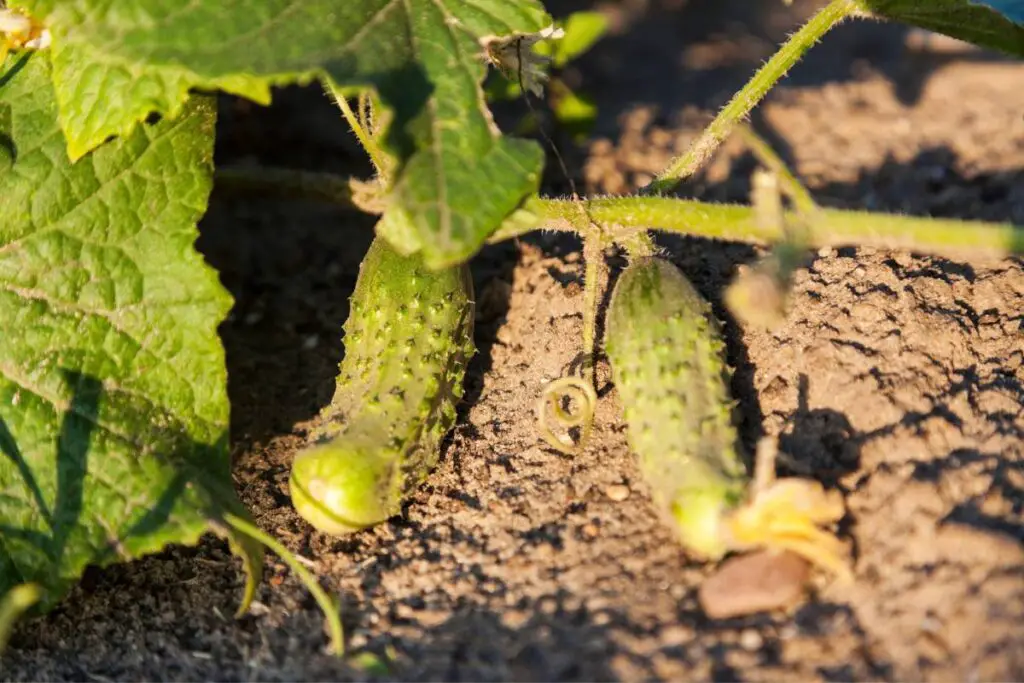
To help the cucumbers get ready for getting picked, provide them with adequate sunlight.
Cucumber plants grow best when they receive 8 to 10 hours of sunlight daily.
If that much is impossible, at least 6 to 8 hours of sunlight is necessary for them.
If the sunlight is intense, protect the cucumbers during the afternoon with a shading cloth or increased watering.
Water
Water the plants with at least 1 inch of water every 1-2 weeks.
Increase the amount to 2 inches when the weather becomes scorching and dry, the sunlight intensifies, and the temperature crosses 90-95°F.
Soil
Cucumbers grow best in well-drained, loamy soil with a pH between 6 and 6.5.
The pH can go up and down based on the type. But most thrive in 6.0 to 6.5.
If your cucumbers are picked up, for example, the pickling cucumbers, they will need soil with pH 5.5 to 6 and a high nitrogen level.
For the English cucumbers, the soil’s pH should be 6.0 and 6.8.
The soil must also contain 2-3% of organic matter.
Cucumbers are not salt-tolerant. So, if you live near salty run-off areas, grow cucumbers in pots or in a different location.
Temperature
Cucumbers thrive best when warm temperatures range between 65 and 75°F.
However, hot temperatures that cross 95°F will damage the plant and the fruits.
To protect the plant from such high temperatures, increase the watering and shade your plant from the intense sunlight.
Temperatures below 50°F can lead to slow growth or no growth at all.
Plant the cucumber seeds two weeks after the last frost, and they will thrive when summer arrives.
Fertilizing
The cucumbers require less nitrogen and high potassium and phosphorus.
Use a fertilizer containing an NPK value of 2-3-6 or 3-6-6.
You can also use a balanced fertilizer with NPK 10-10-10 or 20-20-20.
If you use a slow-release, apply fertilizers every 1-2 months. For liquid fertilizers, use them every 1-2 weeks.
Adding organic matter or mulch can also provide adequate nutrients to plants.
Add 2-3 inches of thick mulch and let them stay in the same place until the vines start running.
Over time, the mulch will break down and add nutrients to the soil.
Types of cucumbers and their intended usages
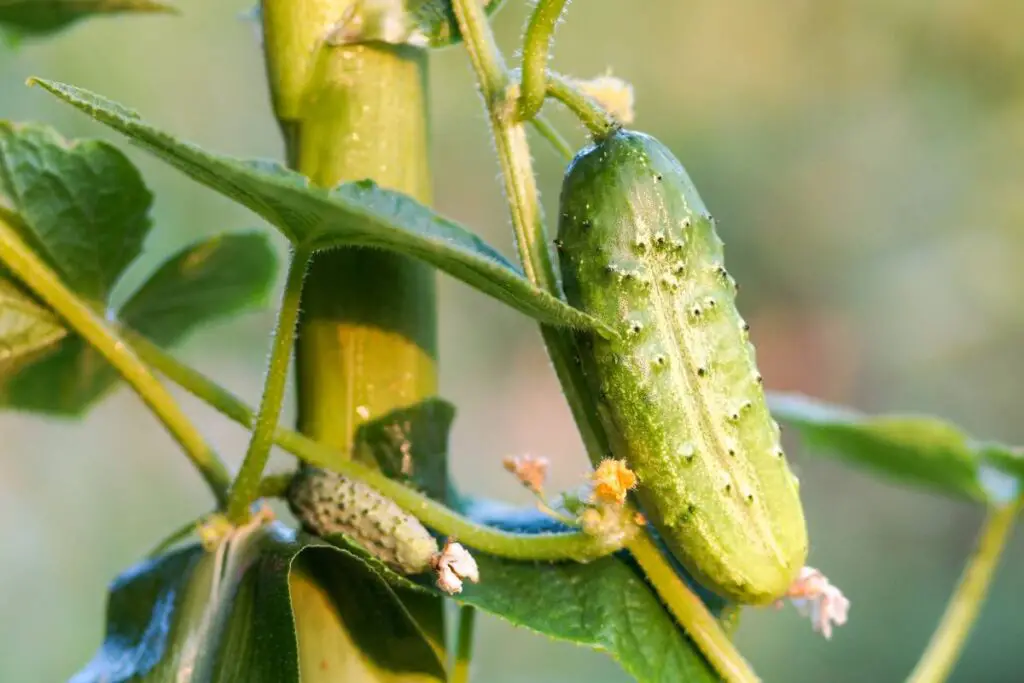
Summer is the season for cucumbers, and their refreshing taste and high water content are what we crave.
Several types of cucumbers are available, and they are used for several purposes.
Generally, cucumbers are divided into two categories – slicing and pickling.
The Kirby, Gherkins, and Lemon fall in the pickling category.
The cucumbers belonging to the slicing category are Japanese, American, English, and Armenian.
This section talks about some common types of cucumbers and their intended usages:
Picklers
These cucumbers are used in pickles and have irregular shapes and sizes of around 3 to 4 inches.
They have bumpy skin, yellow or light to dark green color, and are thicker.
These cucumbers are used to make Mexican dishes like Gazpacho.
Gherkins
Gherkins are small cucumbers measuring 2-3 inches in height.
They are primarily used in Fresh cuisine to enjoy as a side dish.
They are made to use pickles due to their taste and size, which perfectly fit in jars.
Additionally, you can also use them in several cocktails for garnishing.
Kirby
Measuring 6 inches in height, Kirby cucumbers have thin and bumpy skin. They are crispy and have a mild flavor.
Due to their flavor and texture, you can use them in making Gazpacho and Salads.
Lemon
As the name suggests, these cucumbers have the size of a lemon.
They are sweet and crispy when fully ripe.
They are the famous cucumbers with a few seeds and lack the bitterness that most cucumbers have.
You can use them for pickles, smoothies, and cocktails.
Slicing cucumbers
Often called slicers, these cucumbers are added to salads or snacks like sandwiches and burgers.
The average height of these cucumbers is 7-8 inches, and they have dark green skin.
Armenian
These cucumbers have a long length with a twisted texture. They are also called snake melons or cucumbers.
The cucumbers have dark skin with pale green stripes but turn yellow and aromatic once ripe.
Armenians are used to making salads and sandwiches.
Japanese
These long cucumbers measuring 2 feet long are used for salads and sandwiches.
They have dark green skin with a bumpy texture.
English cucumbers
English cucumbers can grow around 12-24 inches long and have dark green skin.
The taste is mild yet sweet.
These are used in making drinks like martini and sake. You will see them wrapped in plastic in supermarkets.
Persian cucumbers
These cucumbers are similar to English ones but come in various sizes.
These cucumbers are stir-fried to be used as toppings on pizzas and salads.
The flavor is mild, and the skin is bumpy.
American cucumbers
These are straight and dark green colored cucumbers with juicy flesh and glossy skin.
The glossiness comes from the wax-coating of the skin that prevents moisture loss.
That is why you must peel them before eating. You can enjoy them as a sauce or add them to salads.
Harvesting in the morning or evening
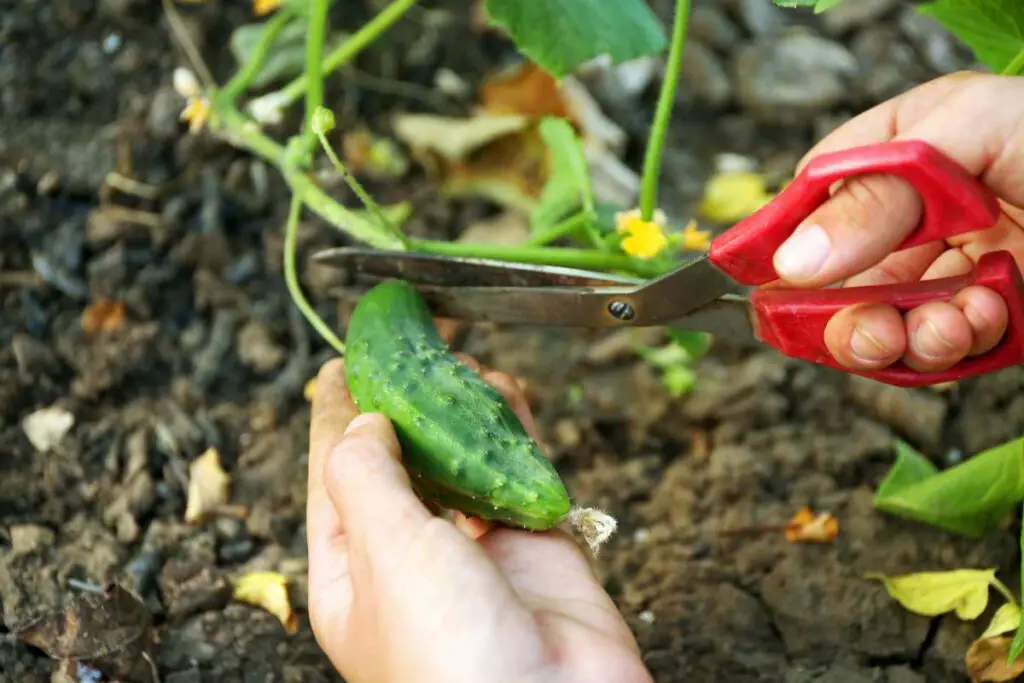
I suggest harvesting the cucumbers in the morning when the vines and stems are damp with dew drops.
Since the vines and stems are damp and cool, the cucumbers become easy to cut.
Harvesting in the early morning will let you enjoy fresh and firm cucumbers without them being affected by the day’s heat and other environmental factors.
Once, I harvested some cucumbers in the morning and some in the evening.
I discovered that the morning cucumbers taste sweeter than the evening harvested ones.
When I told this to one of my friends, he said they tend to have higher sugar content in the morning than in the evening.
You can also harvest in the evening. But the heat of the whole day and the evening’s low temperature can affect the cucumber’s taste.
So, I prefer the morning.
The importance of consistent harvesting
The frequency of harvesting can depend on various factors like the season, the climate, the cucumber variety, and the growth stage.
Generally, cucumbers should be harvested every day or every other day during the season’s peak.
It will keep the cucumbers from getting too ripe or too long.
During the off-peak season, check the plant every 1-2 days and pick up the cucumbers if you feel they mature.
The more cucumbers you pick, the more the plant will produce. Less harvest leads to less yield.
The best way is to check the plants and pick the ripe cucumbers every other morning when the vines are still cool and damp.
You have to pick up multiple cucumbers every other day.
Continue checking the plants regularly and harvest them before they become overripe.
How to harvest the cucumbers?
Once you have confirmed that the cucumbers are ready to pick, please choose the right time (I prefer morning when the weather is excellent).
Harvesting cucumbers is very easy.
You need two tools:
- Gloves
- Precision snips (Fiskars Multi-Snip with Sheath) or Micro pruners (MICRO SNIP LEAF&STEM 5″)
- A garden trug or harvest basket to collect the cucumbers
- Avoid pulling the cucumbers or twisting the vines to remove the cucumbers. That will damage your plant.
- Here are the steps:
- Use snips to hold the fruits from the plant.
- Leave ¼ to 1 inch of the stem in the plant, then cut the cucumbers. Letting this tiny amount of stem stay in the plant will prevent rotting.
- Collect the cucumbers in a garden trug or harvest basket to avoid bruises. Be careful about the burpless varieties as they are prone to bruises.
Tips for prolonging the shelf-life of the harvested cucumbers
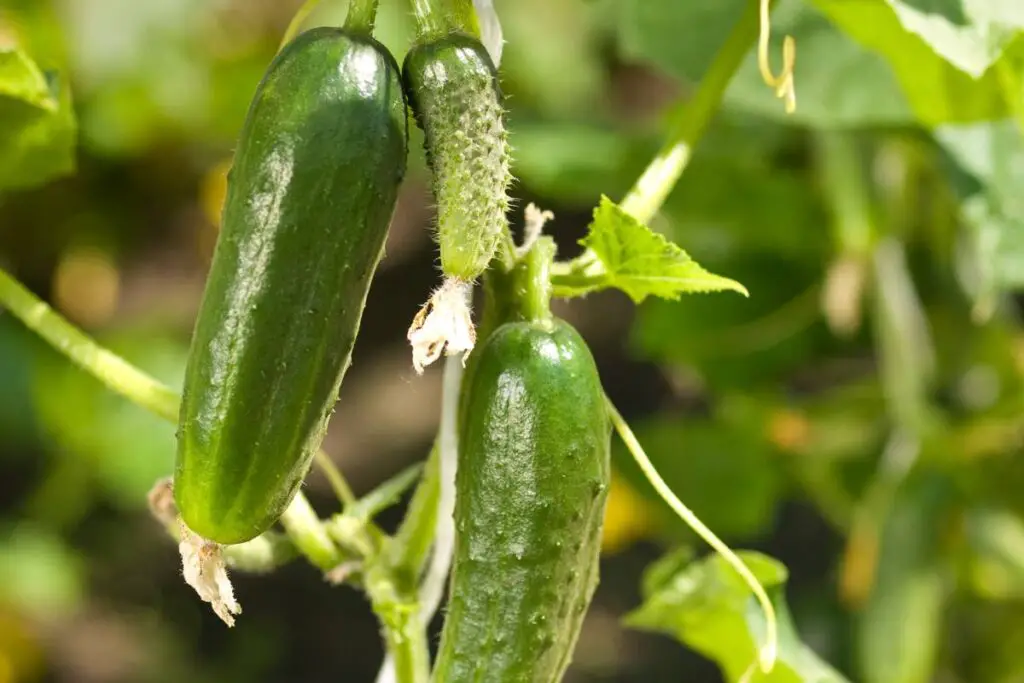
To prolong the lifespan of the harvested cucumbers, you must store them correctly.
Otherwise, it is useless to pick them up if you cannot increase their lifespan.
Remember that cucumbers contain 90-96% of water.
So, storing them correctly is essential to stay fresh until you eat them up.
In the grocery stores, you will see that the cucumbers are coated with wax to prevent moisture loss.
Unlike the other vegetables, the cucumbers will stop ripening after you pick them up.
Here are the steps to prolong the lifespan of the harvested cucumbers:
- Store the pickled varieties in a cool and dark place before making pickles. Since they can be stored longer than the splicing cucumbers, you do not have to keep them in the fridge.
- Store the slicing cucumbers in a crisper bin of your refrigerator.
- Place the cucumbers in a loose plastic or perforated bag. Avoid topping them on top of the other vegetables and fruits.
- You can also use paper towels. Wrap each cucumber separately, put them in the bag, and store them in the crisper bin of the fridge.
- Usually, the cucumbers will stay fine for up to 3 to 5 days.
The paper towel method works the best and excellently increases their lifespan by up to a week.
Cucumbers are enjoyed best when they are eaten immediately after picking them.
Final thoughts
Growing cucumbers is an easy and exciting adventure if you care for them correctly. The cucumbers get ready to pick after 50 to 70 days of planting. However, instead of relying on this timing, consider checking the signs of harvest. The color will change from completely dark green to deep green with some light green hues.
Additionally, the cucumbers will be firm with a bumpy or smooth texture, based on the type. The stems of the cucumber should also be firm, indicating that the cucumber is juicy and plumpy. If your cucumbers taste bitter and contain many seeds, you are late to pick them up.
The mature size of the cucumbers will vary based on the type of cucumbers. For example, pickling cucumbers are ready to pick when they reach 2-4 inches, and slicing cucumbers mature at 5 to 8 inches. The best time to pick the cucumbers is in the morning when the weather is cool. Pick the cucumbers every other day during both the peak and off-peak seasons.
What is the best size to pick the cucumbers?
Though the size depends on the type of cucumbers, the best size to pick the pickling cucumbers is when they reach 2-4 inches long and 6-9 inches for the slicing cucumbers.
What happens if I pick the cucumbers early?
Picking up the cucumbers slightly earlier than the harvest time will give you sweet cucumbers, but they will be more crunchy. Allowing them to ripen fully will give you the best flavor and texture.
Reference: Cucumber Picking Wikipedia
